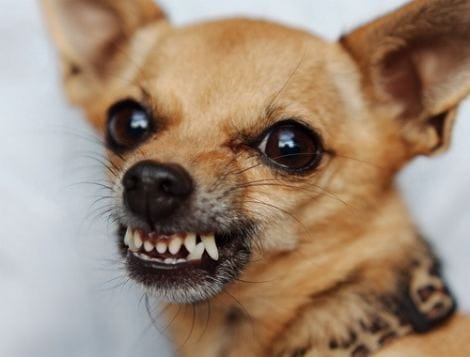Most of us, at one time or another, have been growled at by a dog. It almost always comes as a surprise, and we back away from the dog. This is actually one of those rare moments when we humans correctly interpret dog behavior because growling means “give me space”.
But the space in question might not be theirs to keep and if your dog is growling around you, your family, or other people or pets, there are a few questions you can ask yourself:
- When does he growl, i.e. what is happening?
- Is it only one specific situation or location?
- Is it only with one person or can it be anyone?
There are many reasons for dogs to growl. They may feel threatened, they may feel protective of some resource (food, toys, even a person) or they may be in pain. That’s why the first step is usually to the vet’s office, to rule out any medical problem. If you’ve done that and are sure it’s not medical, the next step is to consider the questions above.
Dog aggression moves up through a set of stages and by the time you get to growling, you’ve missed out on several hints the dog gave using body language. If you continue to ignore those hints, the next step after growling is snapping—and then biting.
But we don’t want to go there, because there’s a lot we can do about a growling dog, assuming she hasn’t already progressed to snapping and biting. Since you already know there’s no medical reason and you have some idea about when growling could occur, what can you do about it?
- Set your dog up for success in her own “safe space”. If you have crate trained your dog, this will be easy. You might need to brush up on cueing your dog to go to her bed and whenever she wants her own space she’ll go there. Just make sure it’s a nice, comfy space that isn’t locked away in a cold, dark basement (unless that’s her preference).
- Don’t reinforce the growling. If she growls over a toy or her food dish, don’t try to take it from her to show her who’s boss. Instead, leave her to eat in peace. If she’s chewing up a toy or something she shouldn’t be, try to offer her something better and more appropriate and once she takes up the new item, calmly remove the item you don’t want her to have.
- Lots of dogs growl and vocalize when they are playing with other dogs. If you live in a multiple dog household and you have one or more dogs growling at each other, keep your eyes and ears open. You may find that it’s all just part of fun and games, to them.
If you’re not sure and you want a professional opinion about whether this is play growling or not, or you know it isn’t all fun and games, feel free to give Applause Your Paws a call. We have experience with all sizes and types of growlers and can help you with yours.


